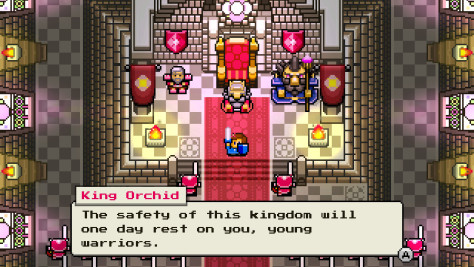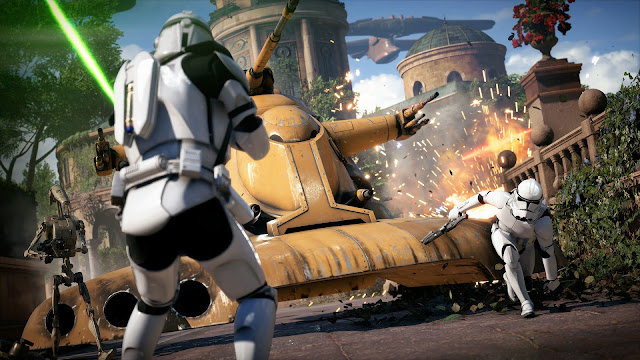"Dew" not miss out on this action-adventure delight.
I adored Ittle Dew 2 when it originally released on the PlayStation 4 in digital form. The game's developer had plans to see if it could work on the Wii U, where no doubt a Legend of Zelda-loving audience would eat such a game up, but alas, the hardware just couldn't muster it. However, a year and some change later, the developer has the game ported to the Nintendo Switch, and with their publishing partner Nicalis, an enhanced version of Ittle Dew 2 sees a retail release in addition to a digital Nintendo eShop one. It's time to depart on a new adventure, dear readers!
Adventurers Ittle and her winged dog Tippsie travel along the high seas on a raft, when all of a sudden it crashes upon an uncharted island. Meeting the island caretaker, the two are told to head back to wherever they came from, but before this is done, Ittle notices a map that falls out of the caretaker's pocket. It reveals the location of eight dungeons around the island where the raft pieces are located. Not heeding the caretaker's words, the pair of adventurers heads off to explore their temporary island residence, searching the countryside for secrets, treasure, caves, and dungeons to enjoy themselves in. Ittle Dew 2+'s story is quite meta in its dialog and story, oftentimes poking fun at concepts seen in games like The Legend of Zelda and the many other titles that have been inspired by Nintendo's historic gaming franchise. It makes for some hilarious, tongue-in-cheek dialog and a story that I truly appreciated. It's nice to not have a super serious story for once for a game like this.
 |
| Explore the island well, Ittle; there are secrets all over the place. |
Nonetheless, it's not just dungeons that are open for exploration. Littered and sprinkled around the island are caves, and many of these require a trick to open. Thankfully, they can all be opened with just Ittle's starting weapon, a stick. Some are right out in the open, while others may require a hint from one of the many NPCs occupying the island. With the Nintendo Switch's screenshot functionality, there's no more need to write down these hints or remember them for later. Just hit the screenshot button, and you've got a hint saved in your screenshot folder via the Switch home menu.
The caves all have some kind of treasure inside to make finding cave worthwhile. Some house crayons that add a quarter of health to Ittle's row of hearts, some have lockpicks to open locked dungeon doors without the need for a key, some have secret shards that unlock optional, demanding dungeons, while some special caves have magical doors that transport Ittle to a completely uncharted area of the island, usually requiring a lot of skill to complete them and acquire the special treasure inside at the end.
 |
| The stick was cute, but now we're getting somewhere with Ittle's sword! |
For instance, in a room where Ittle must activate a northeastern crystal to open a door, if the crystal is guarded by spikes with no means to hit it up close, perhaps spawning an ice block, cutting it in half so the lower right diagonal half of it is gone, and then pushing it diagonally northwest into a corner might start something good. Then, at the bottom left corner of the screen, Ittle can use her rod to shoot a blast of energy out that deflects off the diagonal ice block at an angle and hits the crystal, opening the door. The fun about Ittle Dew 2+ and its puzzles is that there are usually two or more methods of solving them through smart item utilization. Having the player limited to just four items like Ittle Dew 2+ has doesn't mean that there's a limited amount of actions you can do with them. This makes the design on display with Ittle Dew 2+ so brilliant in this regard.
 |
| Push blocks like this from afar with the help of the Magic Rod. |
 |
| Retreat won't look good on an adventurer's resume, but neither would dying to the first enemy in Pepperpain Prairie that Ittle encounters! |
New to Ittle Dew 2+ is a collection of five dungeons found in the Dream World, a place Ittle and Tippsie are taken to once they nap in a sleeping bag within the town. The Dream World can be entered at any time, no matter if you have all of the items in the game or not, as these Dream World dungeons supply you with all you need to complete a specific dungeon. These are primarily puzzle-driven dungeons that are the hardest within the game to wrap one's brain around and solve. The rewards for solving these dungeons aren't anything important to the main quest. Instead, they're merely collectible cards with information on the various foes Ittle encounters within the world of Ittle Dew 2+.
The world of Ittle Dew 2+ is quite beautiful to look at. The 3D character models and environments are colorful and hold a lovely cel-shaded style, making everything pop out like a fairy tale world. The character designs are creative, but I really want to get into the environmental design for a second. It's bursting with creativity, especially the dungeons. From pillow forts, to submerged basements filled with underwater foes, to mines that grow and produce potassium, these places are mighty creative and far more innovative than "Oh, the fire dungeon. Oh, the water dungeon." Each dungeon has a take on a modern-day concept like a basement or house that makes for some clever dungeon concoctions.
 |
| Don't worry -- like these fire-spewing enemies, Ittle has brought the heat to this dungeon, too. |
Ittle Dew 2+ takes a familiar formula with The Legend of Zelda and goes wild with it, offering an abundance of humor, meta commentary, and just phenomenal gameplay and design to back it all up. This isn't a Yooka-Laylee situation where the developers made fun of games they were inspired by, yet committed some of the same sins they poked fun at. (That said, I adored Yooka-Laylee, but that was an obvious issue with the game.) While some movement issues and repeated boss battles bring the overall experience down, the 12 original, well-designed dungeons included within the game, over 50 individual caves to find and plunder, and five all-new, particularly challenging dungeons set in the Dream World for this special bonus edition of Ittle Dew 2, makes for a game that is highly recommended for any action-adventure fan. You should definitely do the Dew.
[SPC Says: B+]












































